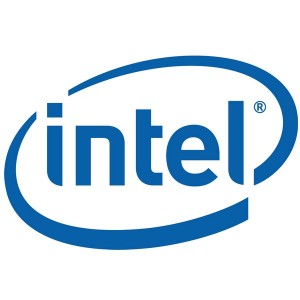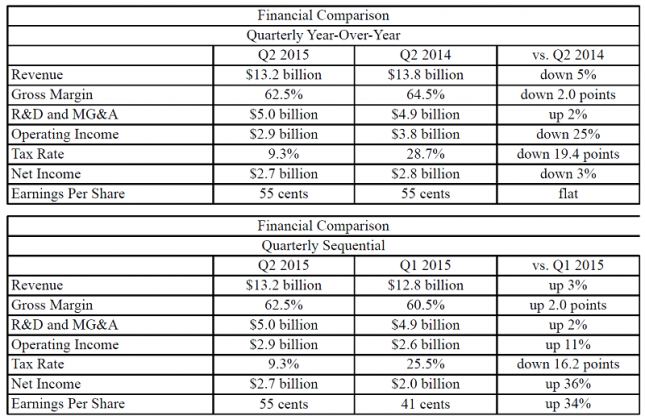Intel Reports Second-Quarter Revenue of $13.2 Billion
Intel Reports Second-Quarter Revenue of $13.2 Billion, Consistent with Outlook
News Highlights:
- Revenue of $13.2 billion consistent with outlook, gross margin of 62.5%, slightly better than outlook
- Client Computing Group revenue of $7.5 billion, up 2 percent sequentially and down 14 percent year-over-year
- Data Center Group revenue of $3.9 billion, up 5 percent sequentially and up 10 percent year-over-year
- Internet of Things Group revenue of $559 million, up 5 percent sequentially and up 4 percent year-over-year
- Software and services operating segments revenue of $534 million, flat sequentially and down 3 percent year-over-year
- Qualified Intel 6th Gen Intel Core processor (Skylake) for production, which will deliver exciting new PC experiences in the second half of 2015
SANTA CLARA, Calif., July 15, 2015 — Intel Corporation today reported second-quarter revenue of $13.2 billion, operating income of $2.9 billion, net income of $2.7 billion and EPS of 55 cents. The company generated approximately $3.4 billion in cash from operations, paid dividends of $1.1 billion, and used $697 million to repurchase 22 million shares of stock.
Second-quarter results demonstrate the transformation of our business as growth in data center, memory and IoT accounted for more than 70 percent of our operating profit and helped offset a challenging PC market,” said Intel CEO Brian Krzanich. We continue to be confident in our growth strategy and are focused on innovation and execution. We expect the launches of Skylake, Microsoft’s Windows* 10 and new OEM systems will bring excitement to client computing in the second half of 2015.
Intels Business Outlook does not include the potential impact of any business combinations, asset acquisitions, divestitures, strategic investments and other significant transactions that may be completed after July 15.
Q3 2015
- Revenue: $14.3 billion, plus or minus $500 million.
- Gross margin percentage: 63 percent, plus or minus a couple of percentage points.
- R&D plus MG&A spending: approximately $4.9 billion.
- Restructuring charges: approximately $175 million.
- Amortization of acquisition-related intangibles: approximately $70 million.
- Impact of equity investments and interest and other: approximately $100 million net gain.
- Depreciation: approximately $2.0 billion.
Full-Year 2015
- Revenue: down approximately one percent.
- Gross margin percentage: 61.5 percent, plus or minus a couple of percentage points.
- R&D plus MG&A spending: $19.8 billion, plus or minus $400 million.
- Amortization of acquisition-related intangibles: approximately $265 million.
- Depreciation: $7.9 billion, plus or minus $100 million.
- Tax rate: approximately 26 percent for the third and fourth quarters.
- Full-year capital spending: $7.7 billion, plus or minus $500 million.
For additional information regarding Intels results and Business Outlook, please see the CFO commentary at: www.intc.com/results.cfm.
Status of Business Outlook
Intels Business Outlook is posted on intc.com and may be reiterated in public or private meetings with investors and others. The Business Outlook will be effective through the close of business on September 11 unless earlier updated; except that the Business Outlook for amortization of acquisitionrelated intangibles, impact of equity investments and interest and other, restructuring charges, and tax rate, will be effective only through the close of business on July 22. Intels Quiet Period will start from the close of business on September 11 until publication of the companys third-quarter earnings release, scheduled for October 13. During the Quiet Period, all of the Business Outlook and other forward-looking statements disclosed in the companys news releases and filings with the SEC should be considered as historical, speaking as of prior to the Quiet Period only and not subject to an update by the company.
Risk Factors
The above statements and any others in this release that refer to plans and expectations for the second quarter, the year and the future are forward-looking statements that involve a number of risks and uncertainties. Words such as “anticipates,” “expects,” “intends,” “plans,” “believes,” “seeks,” “estimates,” “may,” “will,” “should” and their variations identify forward-looking statements. Statements that refer to or are based on projections, uncertain events or assumptions also identify forward-looking statements. Many factors could affect Intel’s actual results, and variances from Intel’s current expectations regarding such factors could cause actual results to differ materially from those expressed in these forward-looking statements. Intel presently considers the following to be important factors that could cause actual results to differ materially from the company’s expectations.
- Demand for Intel’s products is highly variable and could differ from expectations due to factors including changes in business and economic conditions; consumer confidence or income levels; the introduction, availability and market acceptance of Intel’s products, products used together with Intel products and competitors’ products; competitive and pricing pressures, including actions taken by competitors; supply constraints and other disruptions affecting customers; changes in customer order patterns including order cancellations; and changes in the level of inventory at customers.
- Intel’s gross margin percentage could vary significantly from expectations based on capacity utilization; variations in inventory valuation, including variations related to the timing of qualifying products for sale; changes in revenue levels; segment product mix; the timing and execution of the manufacturing ramp and associated costs; excess or obsolete inventory; changes in unit costs; defects or disruptions in the supply of materials or resources; and product manufacturing quality/yields. Variations in gross margin may also be caused by the timing of Intel product introductions and related expenses, including marketing expenses, and Intel’s ability to respond quickly to technological developments and to introduce new products or incorporate new features into existing products, which may result in restructuring and asset impairment charges.
- Intel’s results could be affected by adverse economic, social, political and physical/infrastructure conditions in countries where Intel, its customers or its suppliers operate, including military conflict and other security risks, natural disasters, infrastructure disruptions, health concerns and fluctuations in currency exchange rates. Results may also be affected by the formal or informal imposition by countries of new or revised export and/or import and doing-business regulations, which could be changed without prior notice.
- Intel operates in highly competitive industries and its operations have high costs that are either fixed or difficult to reduce in the short term.
- The amount, timing and execution of Intel’s stock repurchase program could be affected by changes in Intel’s priorities for the use of cash, such as operational spending, capital spending, acquisitions, and as a result of changes to Intel’s cash flows or changes in tax laws.
- Intel’s expected tax rate is based on current tax law and current expected income and may be affected by the jurisdictions in which profits are determined to be earned and taxed; changes in the estimates of credits, benefits and deductions; the resolution of issues arising from tax audits with various tax authorities, including payment of interest and penalties; and the ability to realize deferred tax assets.
- Gains or losses from equity securities and interest and other could vary from expectations depending on gains or losses on the sale, exchange, change in the fair value or impairments of debt and equity investments, interest rates, cash balances, and changes in fair value of derivative instruments.
- Product defects or errata (deviations from published specifications) may adversely impact our expenses, revenues and reputation.
- Intel’s results could be affected by litigation or regulatory matters involving intellectual property, stockholder, consumer, antitrust, disclosure and other issues. An unfavorable ruling could include monetary damages or an injunction prohibiting Intel from manufacturing or selling one or more products, precluding particular business practices, impacting Intel’s ability to design its products, or requiring other remedies such as compulsory licensing of intellectual property.
- Intel’s results may be affected by the timing of closing of acquisitions, divestitures and other significant transactions.
Earnings Webcast
Intel will hold a public webcast at 2 p.m. PDT today on its Investor Relations website at www.intc.com. A webcast replay and MP3 download will also be available on the site. Intel plans to report its earnings for the third quarter of 2015 on October 13. Immediately following the earnings report, the company plans to publish a commentary by Stacy J. Smith, Intel CFO and executive vice president, at www.intc.com/results.cfm. A public webcast of Intels earnings conference call will follow at 2 p.m. PDT at www.intc.com.
About Intel
Intel (NASDAQ: INTC) is a world leader in computing innovation. The company designs and builds the essential technologies that serve as the foundation for the worlds computing devices. As a leader in corporate responsibility and sustainability, Intel also manufactures the world’s first commercially available “conflict-free” microprocessors. Additional information about Intel is available at newsroom.intel.com and blogs.intel.com and about Intel’s conflict-free efforts at conflictfree.intel.com.


